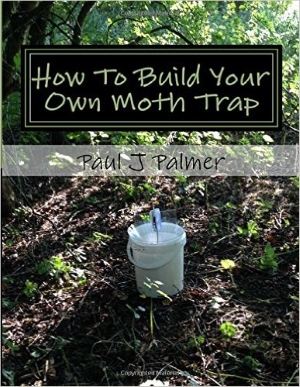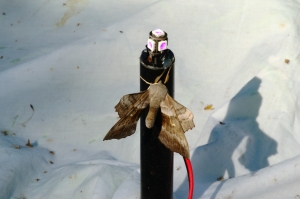Build Your Own LED Moth Trap - guest blog by Paul Palmer
 UPDATE: We now have a series of video guides on how to build your own moth trap.
UPDATE: We now have a series of video guides on how to build your own moth trap.
Returning to moth recording after a gap of too many years to count, I took a fancy to build a cheap, lightweight moth trap to use at a favourite nearby locality, Rutland Water. Reducing the cost to a minimum soon became an important additional aspect to my hobby.
My first moth trap was built in the late 1960s and was based on ideas taken from early copies of the Amateur Entomologist's Bulletin, loaned to me by a local entomologist. It used an old tea chest, which was a kind of wooden box and still smelt of tea, with a 100W light bulb. It lit up the neighbours' bedroom windows (to their puzzlement!) and caused a series of grumbles. On the plus side, it caught a wonderful series of moths.
Later, I progressed to using actinic fluorescent tubes driven through an inverter intended for camping use, a light source that was less intrusive to our now fairly tolerant neighbours, and caught even more moths. The term actinic refers to the ultraviolet (UV) output of the lamp, to which many insects are attracted.
Building these traps taught me two things: the importance of using a light source with an actinic component; and adapting technology intended for one application into another, often unrelated, application. The moth trap market is very small, so commercial traps are necessarily expensive, but there are plenty of components out there that can be adapted to be used in moth traps. In the spirit of those articles that inspired me, in my book I have tried to provide enough detail for anyone to follow the design and build process.
 The final design of moth trap involved several years of experimentation with a range of materials and light sources. None of the experiments was ever a complete failure, but the final design using 0.75W UV LEDs works about as well as established trap designs using an 8W actinic tube. These LED traps can be powered using AA batteries of the correct type and are lightweight, so can be carried easily to survey sites. In a garden the trap can be powered using a suitable power supply or other types of battery. Any DC supply from 5 Volts to 25 Volts will do as long as it is rated above 3 Watts.
The final design of moth trap involved several years of experimentation with a range of materials and light sources. None of the experiments was ever a complete failure, but the final design using 0.75W UV LEDs works about as well as established trap designs using an 8W actinic tube. These LED traps can be powered using AA batteries of the correct type and are lightweight, so can be carried easily to survey sites. In a garden the trap can be powered using a suitable power supply or other types of battery. Any DC supply from 5 Volts to 25 Volts will do as long as it is rated above 3 Watts.
The final design of the moth trap comprised of four parts: a box; a funnel; baffles; a lamp holder; and the lamp. The approach adopted was to buy the box, then make the funnel, baffles and lamp holder from suitable plastic sheet. With the addition of some purchased electronic components to regulate the voltage for the UV LED bulb and the inclusion of a dawn dusk sensor, all housed in a food storage box, one can build a cheap working moth trap. If you follow the instructions in the book, you can have one too! In my records I call it a “0.75W UV LED Bucket Trap”.
 The photograph shows the trap in use in November 2015, giving excellent results very late in the season with numerous Feathered Thorns clustered about the funnel. The trap design can be adapted to suit your particular requirements. In a garden situation a more robust storage box can be used by cutting a suitable aperture in the box lid. The number of LED bulbs may be increased and other colours of LEDs added to the mix. A mains adaptor will be needed to do this. Alternatively the cone may be made of more sections and held together with nuts and bolts to make a flat pack trap to take on holiday.
The photograph shows the trap in use in November 2015, giving excellent results very late in the season with numerous Feathered Thorns clustered about the funnel. The trap design can be adapted to suit your particular requirements. In a garden situation a more robust storage box can be used by cutting a suitable aperture in the box lid. The number of LED bulbs may be increased and other colours of LEDs added to the mix. A mains adaptor will be needed to do this. Alternatively the cone may be made of more sections and held together with nuts and bolts to make a flat pack trap to take on holiday.
There are many possibilities, but start by building the trap following the instructions in the book chapters. Some basic instructions for use of the trap are given in the final chapter of the book. If you are new to running a moth trap, do try to make contact with other enthusiasts in your area who will be really happy to offer advice and support.
Happy Mothing!
Paul J. Palmer is a Leicestershire based entomologist and author of the book 'How to build your own moth trap'. The book can be purchased through Amazon or ordered from any bookshop:
ISBN-10: 1523690631
ISBN-13: 978-1523690633
The FSC run several courses on moth identification. Find them listed here.
- Anonymous's blog
- Log in or register to post comments



